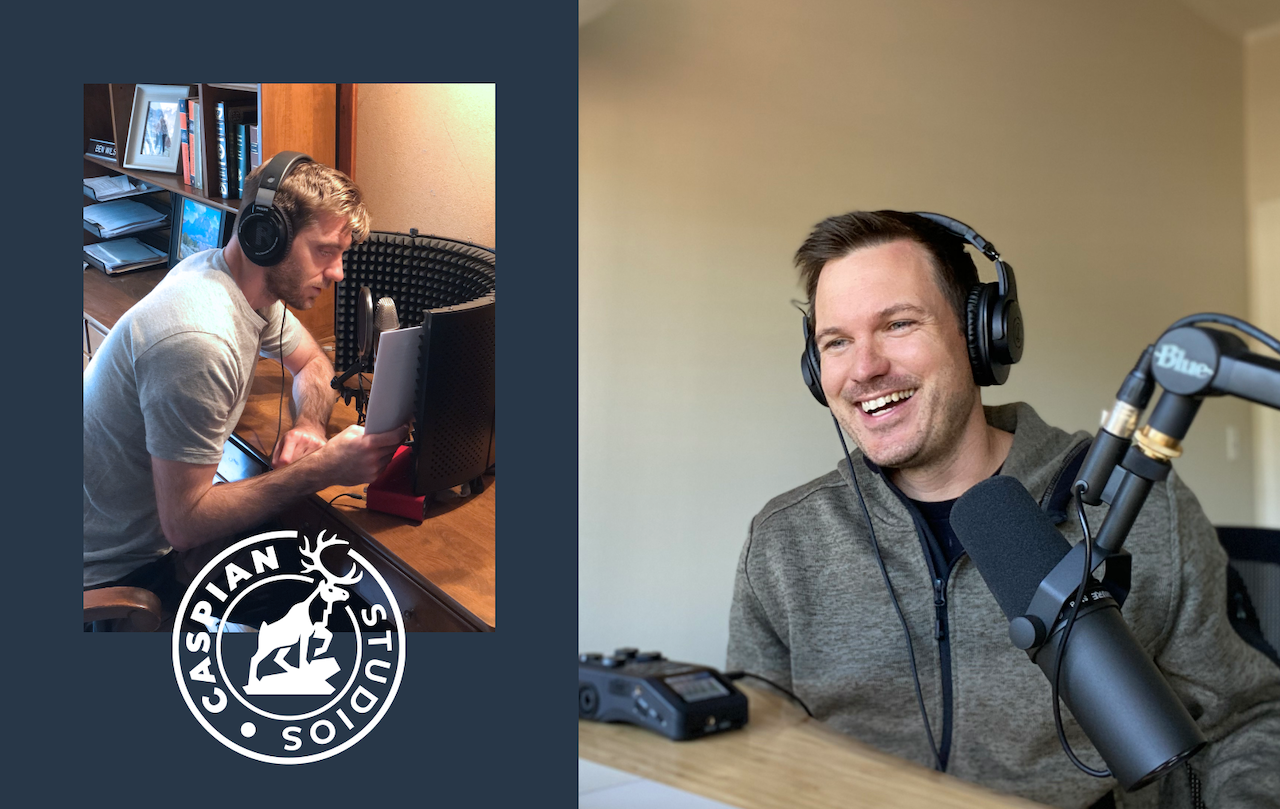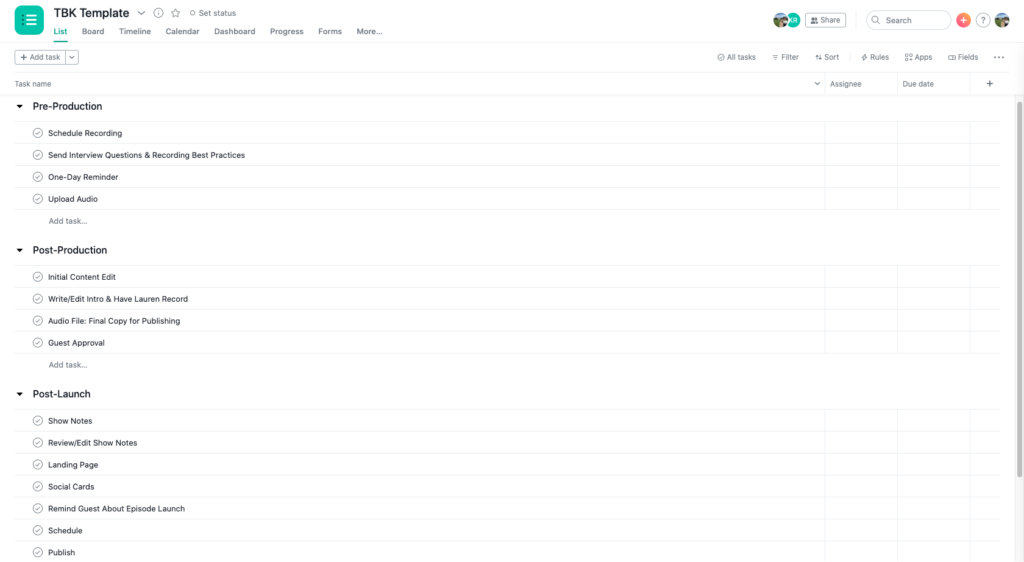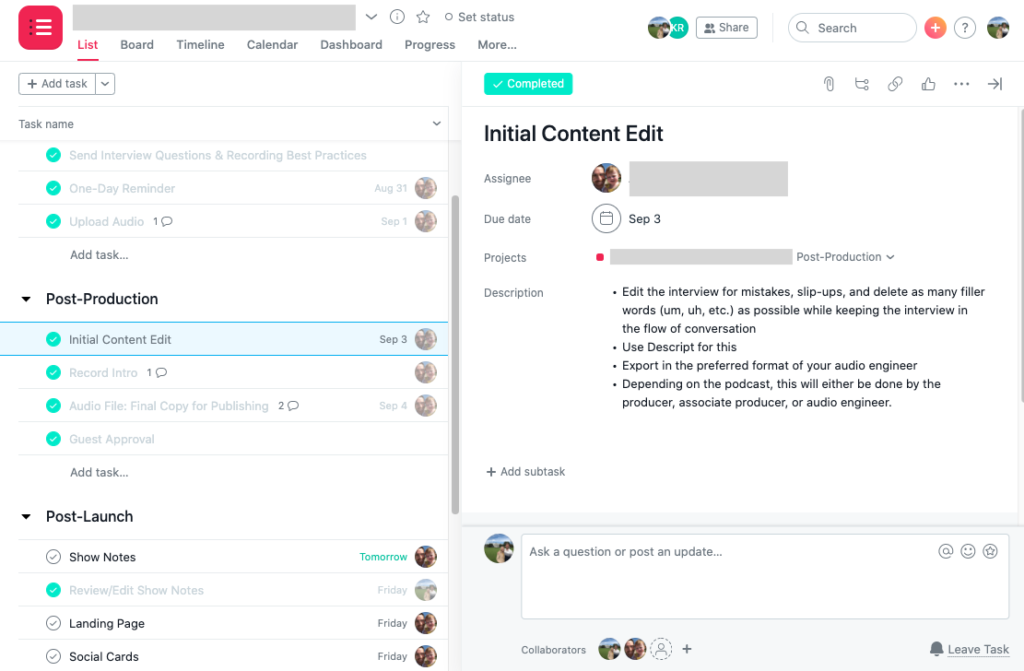From zero to ten podcasts: How Caspian Studios produces B2B podcasts with Asana

Read this article in French, German, Portuguese, Spanish, or Japanese.
Caspian Studios CEO, Ian Faison describes the “on-demand audio revolution” as still being in its early stage of development. Even still, the appetite for podcasts has spread like wildfire—it isn’t uncommon to listen to podcasts while working out, during a commute, or on a long drive.
But the transition to remote work and virtual events as a result of COVID-19 has created an appetite for a new type of podcast: B2B enterprise podcasts, where companies can engage their communities and provide value in a new, digitally-accessible format. Ian and Head of Content, Ben Wilson are at the forefront of this field, and Caspian Studios offers what they call “enterprise podcast as a service.” Since February, they’ve partnered with companies like Slack, Zoom, Okta, Oracle, Qualified.com, and IBM—just to name a few.
To learn more about how Caspian Studios produces and distributes podcasts, we sat down with Ian and Ben to learn more about how they conceptualize, create, and promote their podcasts. Here’s what they had to say:
Q: Before we dive into how you produce so many podcasts, we’d like to learn a bit about each of you.
Ian: As the CEO of Caspian Studios, I do a bit of everything. I split my time between working with Ben to create the content and with our Head of Customer Success, Kyle Rusca to manage the relationship with our customers and guests. I also host a handful of the shows, and executive produce shows to ensure they have the Caspian look, feel, and polish.
Ben: As the Head of Content, I focus on “making the sausage,” as we like to say. I work with our team of producers and audio engineers to take a podcast from vision to reality. This includes overseeing the early phases of iteration, ideation, and writing if it’s a scripted show. After that, we QA and edit, to make sure the podcast quality is up to snuff.
Q: What inspired you to start Caspian Studios?
Ian: I was in the Army for ten years, and when I got out, I really wanted to get into sales and marketing. My manager at the time wasn’t the best mentor, so I turned to podcasts. My own interest made me realize that there were others like me—professionals looking for cutting-edge business practices from the smartest people in the world—who wanted access to the executives and operators with that knowledge. In turn, there were many executives and operators who had the knowledge but didn’t have a great outlet to share their stories.
These two groups—professionals and executives—are united by a third group: the marketing teams at B2B enterprise technology companies, who want a scalable, engaging, turn-key solution to provide value to their audience and customers.
Our customers are CMOs and marketing teams who want to create an incredible podcast and don’t want to do all the work. And they want someone who has the expertise and has done it many times. We work on every step of the podcast creation process: from ideation and creation to publishing, creating a website, working on the email newsletter, social media assets, you name it. If you are spending money on a podcast, you want to make sure you are actually marketing it to new people. We do all of that. And it integrates into their current marketing, demand gen, and sales engine.
So our job at Caspian Studios is to deliver a phenomenal customer experience and, ultimately, create a great show. We’re here to help our clients create a show that they’re super proud of, listeners love, and guests want to be on.
Q: How do B2B podcasts, especially those by enterprise companies, differ from “traditional” podcasts?
Ian: I think podcasts are a lot of things to a lot of different people. There are a ton of consumer production companies creating these super smash hit shows, but nobody was focusing on the B2B side.
“For me, the underserved market is folks who focus on how business leaders can improve their companies in a professional, curated, and well-produced way.”
Ian Faison, CEO, Caspian Studios
For example, there are creative marketing teams that are on the cutting-edge of their industries, and they have a lot of great secrets and lessons to share with others in their industry. It’s a totally different utility than a traditional podcast that focuses on sports, pop culture, or politics. We create podcasts around a specific listener persona. For example, our Demand Gen Visionaries podcast is for marketers, while our Over the Edge podcast is for edge computing professionals. Our goal is to provide edu-tainment with a helpful, interesting podcast that gives you insights that help you become better in your career. It might be something that becomes part of your weekly or monthly routine, and helps you stay up on what’s happening at the cutting edge—straight from the mouth of the people actually doing it.
Q: Can you walk us through the podcast creation process? How much of this is templatized, and how much of it varies from podcast to podcast?
Ben: It depends on the style of the show. We have project templates for each style—interviews, narrated, or blended—and then we tweak it depending on the customer’s needs.
For example, in an interview style show, we start by identifying who is going to be interviewed. Then we prep everything for that interview—that includes all of the questions that are going to be asked and anything else we need in the pre-production process. Once we have the interview, we move into the post-production process, which includes editing, inserting any extra audio, approvals, that type of stuff. Finally, we launch the episode and promote it so it ends up in people’s feeds.
Ian: Asana is integral for us. Every aspect of the episode needs to be done correctly and in a specific order, and several things—like people’s names and titles—need to be triple checked. We’ve created custom project templates with anywhere from 18 and 20 tasks per episode. We start with a solid baseline and then customize the template for the exact show as needed. It’s critical for us to track every step in one place so nothing is forgotten.

Q: There are so many moving parts to producing a podcast. How do you track all of this work in Asana?
Ian: We launched the company in February and one of the first things we did was get Asana. I knew we were going to use Asana to track our process from the very first show we did, Winning Retail.
“If it’s not in Asana, it doesn’t happen.”
Ian Faison, CEO, Caspian Studios
When we start a new show, like our CIO Confidential show with Okta, Box, Slack, and Zoom, we create a Team in Asana and add the people working on that show as members. Then each episode is managed in a project and taken through the process of pre-production, post-production, and post-launch, with anywhere between four and ten tasks in each of those sections.
Ben: We also create a Google Drive folder for each show, and give everyone on the team access to the folder. That way, we can create any docs or sheets and share them in Asana with the Google Drive integration without worrying about whether or not the person will have access.
Ian: It is critical to have everything in one place. As I mentioned earlier, we create a ton of content for each episode and all of those assets have to be created, approved, and published.
Q: How do you use Asana to make sure everyone is on the same page?
Ben: Our in-house team is pretty small, but we work with extremely talented freelancers and contractors across many of our shows. When we “onboard” a new producer, we start by adding them to an existing project and letting them cruise around. In all of the project templates, each task has the exact context and details a producer needs to complete that step. This makes it very clear, and has helped us scale. We now have 10 shows going simultaneously, and templates in Asana make it easy for new producers to come in and get right to work.

Q: What are your top tips for producing podcasts with Asana?
Ian: Definitely creating a Team for the show and using a project template that has all of the tasks in there, so you can copy the template for each new episode. With podcasts, there are so many small, hidden tasks that can be easy to forget. Every time a new recurring task pops up, add it to your template so it’s not missed moving forward.
Ben: Something that’s key for podcasts in general is consistency. Podcasts are usually part of a listener’s routine, so they need to know that when they go into their feed your podcast is going to be there for them to listen to. I think that’s where a lot of podcasters go wrong—they produce a few episodes then they take some time off. Having that consistency really helps you develop a relationship with your audience so they can integrate your content into a regular part of their life. Templates in Asana are integral to helping us stay consistent; we know exactly what we need to do to get the episode out on schedule and promote it to our audience.
Ian: Lastly, I’d say the most important thing is to build content for your audience. You need to have a deep understanding of their persona, and why and where they’re listening to the show, so you can nail the right length and feel. It all stems from there.
Q: What’s next for Caspian Studios?
Ian: We’re going to have a ton more shows in production next year. We have a lot of companies we’re talking to right now, and we’re developing more shows that will cover different topics. And we’re always producing more enterprise-grade, industry-leading serialized podcasts, so stay tuned. If you want a custom podcast, drop us a line!
We’re inspired by customers like Caspian Studios who are using Asana to achieve their missions. See what teams around the world are doing with Asana.

